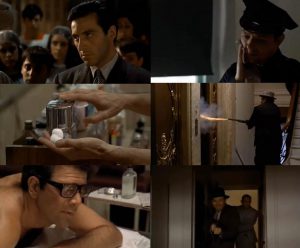The release of the Godfather in 1972 represented a milestone in Hollywood cinema in many ways. Not only was it critically acclaimed, it had was one of the highest grossing films ever made, managing to save Paramount studios from the brink of collapse at the time, and in the process cementing director Francis Ford Coppola’s standing in Hollywood. It is thus perhaps ironic that he never intended this success to happen, wanting to tell small, personal stories. In fact, he saw the film, specifically the Mafia, as a metaphor for America and capitalism, and how both will do anything to protect and perpetuate itself.
The general narrative of the story highlights the perils of capitalism and Michael’s actions, in particular, represent the collapse of the American Dream in many ways. The film, taking inspiration from Italian neorealism, repeatedly emphasizes the importance of family to the main characters. As said by Vito Corleone in the film, “A man who doesn’t spend time with his family can never be a real man”. They try their best to protect each other and when tragedy occurs, such as Vito’s shooting or Sonny’s death, the family members’ emotions are clear and they rally together, wanting to avenge the fallen. Solidarity between family is in place despite lack of institutional solidarity.
Vito as a father and grandfather wants the best for his family, despite his violence. He attempts to secure this status through his work which makes money, which secures the safety of his family as the money enables him to pay off the police and politicians, which in turn helps ensure his family’s safety. This process could be described as the “mafia” version of the American Dream, climbing the sociopolitical ladder and making money through capitalism.
In the final scene, we see one of the few instances that parallel editing is employed in the film. The editing, combined with the masterful sound design of Walter Murch combine to make this an iconic scene. The pace of the cuts, as well as the volume of the church organs increases as the scene progresses to its climax, effectively building more tension. We see Michael being born into his role as godfather while his baby nephew is being baptized, another kind of birth into a new world. Aside from the obvious irony of Michael renouncing the devil while committing multiple sins – murders that he ordered – the presence of the baby suggests a kind of newness, that Michael will be a very different kind of Don compared to his father, someone much more ruthless, and the rebirth of the Corleone family’s power. The dual nature of parallel editing also symbolizes the dual nature of the life he will now have to lead, hiding his true nature of his work from his wife Kay. This point comes to fruition with the final scene of the film, with his lie to her, and her eventual realization as the door of his office separates them. His previous murders also put his family in danger, something his father would likely not have done. Michael’s pursuit of the Godfather’s version of the American Dream thus leads to the starting of the inevitable collapse of his marriage and in turn his family ties.
